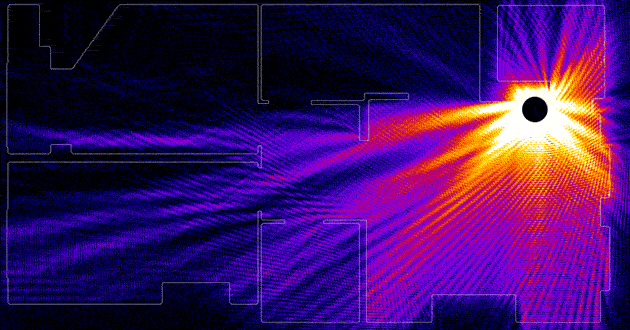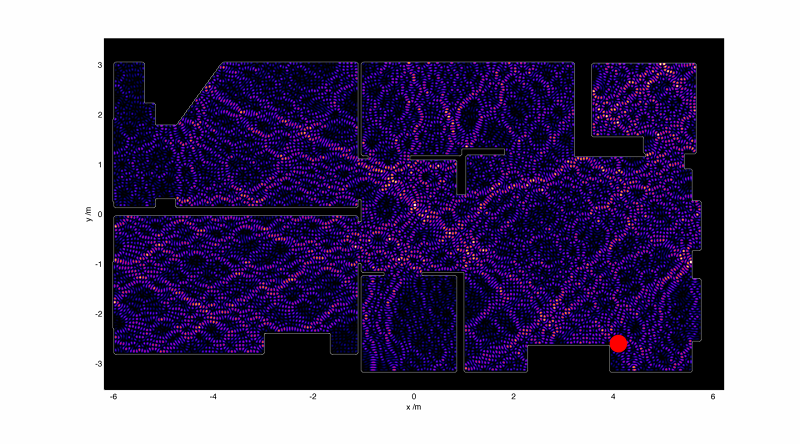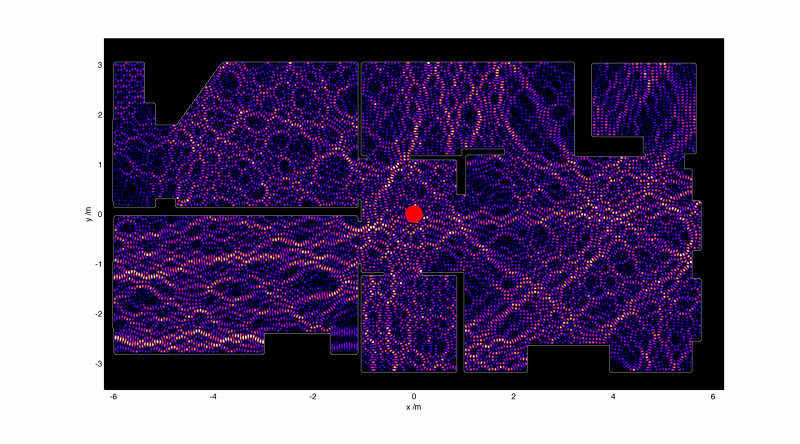What’s the point of having a beastly fiber-optic Internet connection if you’re bogging yourself down with Wi-Fi AND walls. Sure, you can pivot around in hopes of catching a whiff of that Wi-Fi tendril to expedite your Netflix stream, but the fact of the matter is that Wi-Fi falls short when walls are involved. What’s the use of living in a spacious apartment if your Internet use is confined to specific sections of the home? Fed up with this first-world handicap, physics Ph.D. student Jason Cole set out map his apartment and apply the Helmholtz equation to model Wi-Fi reception to find the best reception.

The Helmholtz equation, named after German physicist Hermann von Helmholtz, models “the propagation of electromagnetic waves” using a sparse matrix to determine the paths and interferences of waves. In this instance, Cole applied the matrix to the waves emanating from the Wi-Fi router.
To perform the experiment, Cole first mapped his apartment, set up a Wi-Fi antenna as a radiation source, and solved the equation in two dimensions while assigning refraction values to the walls. Solid walls have a very high refractive index, whereas hollow walls are assigned a refractive index of 1. Next, the equation was applied to Cole’s apartment’s long and narrow two-bedroom layout using complex mathematical modeling more accurately described in his blog.
The corner where he first placed the antenna yielded some rather startling results: “I would have expected to see some region of ‘brightness’ around the electromagnetic source, fading away into the distance perhaps with some funky diffraction effects going on. Instead we get a wispy structure with filaments of strong field strength snaking their way around. There are noticeable black spots too, recognizable to anyone who’s shifted position in a chair and having their phone conversation dropped.” It’s evident that even strong signals can deflect off walls to reach remote areas of a home.
 Cole then proceeded to move the antenna around in different parts of the apartment in an effort to optimize coverage. His next set-up tracked reception originating from the kitchen; this improved coverage in all areas besides the bedroom. However, placing the router directly in the center of the apartment exhibited “Internet goodness” throughout each room. While this may come as no surprise, it’s the first time someone actually mapped the electromagnetic wave distribution to confirm this.
Cole then proceeded to move the antenna around in different parts of the apartment in an effort to optimize coverage. His next set-up tracked reception originating from the kitchen; this improved coverage in all areas besides the bedroom. However, placing the router directly in the center of the apartment exhibited “Internet goodness” throughout each room. While this may come as no surprise, it’s the first time someone actually mapped the electromagnetic wave distribution to confirm this.
 Introducing time into the equation allowed Cole to simulate how the apartment gradually fills with waves that form pockets of high activity. It’s worth noting that the Wi-Fi signal curved relatively smoothly around the doorway in the second bedroom, creating decent reception down a central stream a couple of feet down the center. There’s even reception in the remote corner of the second bedroom; this implies that you could snatch some connectivity by skulking around with your laptop in far off corners of the house.
Introducing time into the equation allowed Cole to simulate how the apartment gradually fills with waves that form pockets of high activity. It’s worth noting that the Wi-Fi signal curved relatively smoothly around the doorway in the second bedroom, creating decent reception down a central stream a couple of feet down the center. There’s even reception in the remote corner of the second bedroom; this implies that you could snatch some connectivity by skulking around with your laptop in far off corners of the house.
Source: Jason Cole/Ars Technica
Advertisement
Learn more about Electronic Products Magazine





